Writing good advertising headlines is 80% of the sale, or, as David Ogilvy famously said, “When you have written your headline, you have spent eighty cents out of your dollar.”
You can apply the same concept to any marketing campaign, not just blogs. An interesting headline is the key to catching people’s attention who are used to swiftly scrolling through a wall of information on their phones.
Keep reading to gain inspiration from a roundup of some of the best ad headline examples and discover what makes an excellent copy — straight from the classics to the modern hits.
Grab Your Readers’ Attention with These Catchy Headline Resources
This downloadable bundle is perfect to help you get the most out of the knowledge in this post. You will receive a list of emotional words to include in your headlines, an infographic covering what makes a headline catchy, and an editorial calendar to help you plan out all of your content ahead of time.
What Makes a Catchy Headline?
Behind every great headline is a brilliant marketer who did their homework. They know their audience, understand their problems, and are not afraid to get creative.
Here are some of my favorite principles when it comes to headline writing:
Know Your Audience
What’s their main pain point? What do they like/dislike? Use “you” instead of “we” or give the readers a vivid mental image of them using the product. Make the headline hyper-optimized for your persona.
Some marketers take ideas from social listening tools, for example.
Make It Clear What Problem You’re Solving
People don’t have time to read. Get to the point quickly and make the message super clear. It helps to use actionable or emotional words. It also makes for easier lead generation.
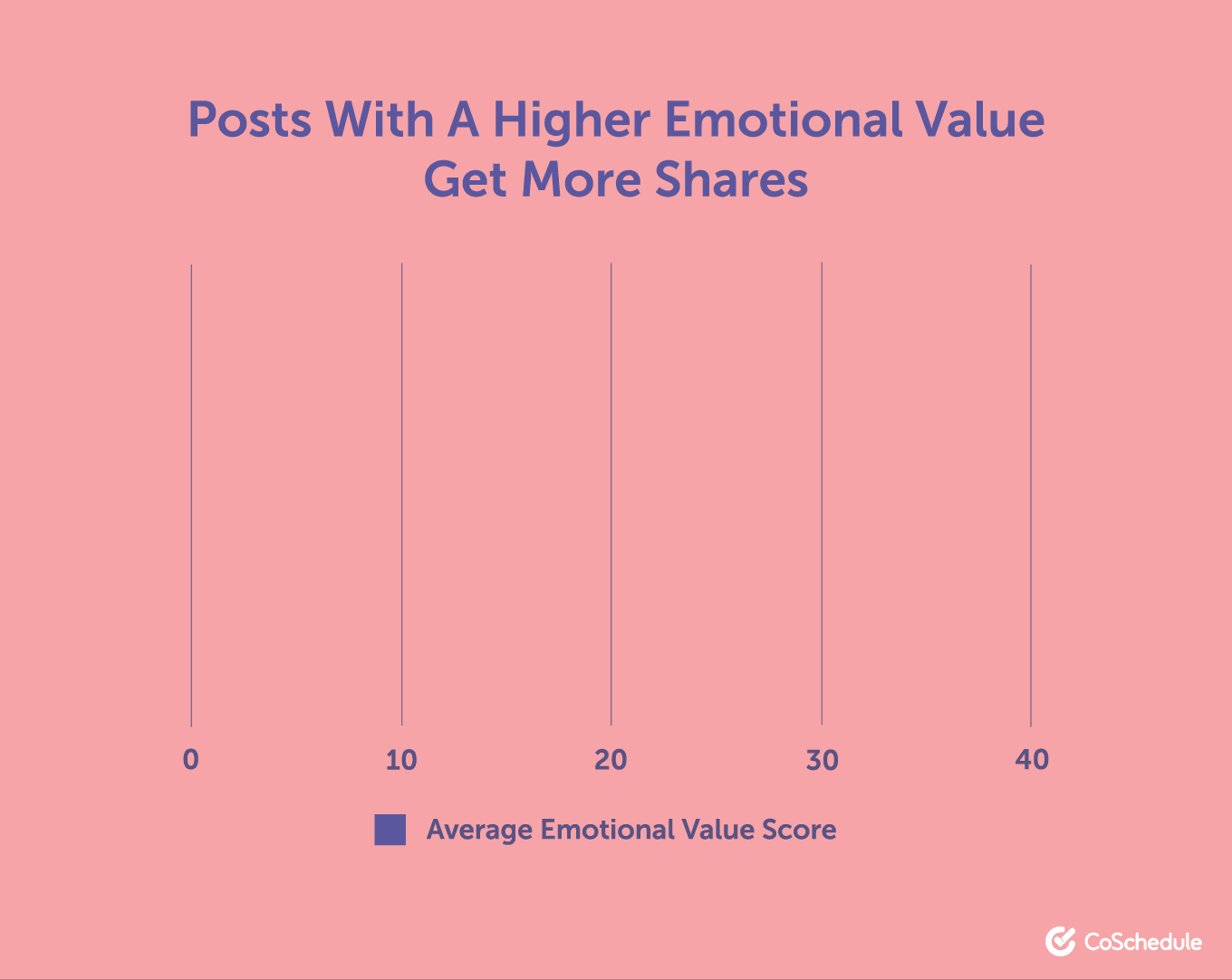
Sell Outcomes, Not Features
Think of any one of Nike’s ads. They feature determined, motivated people. Nike hardly talks about their sleek design or comfortable fit. It’s all about selling a promise.
Use Numbers
When possible, incorporate numbers into your headline. It helps people to better visualize your offer.
Ready With Your First Few Drafts?
The perfect headline is made up of numerous elements, and you want to make sure you’ve ticked off everything from your checklist before hitting “publish”.
This is where CoSchedule’s Headline Analyzer Studio comes in.
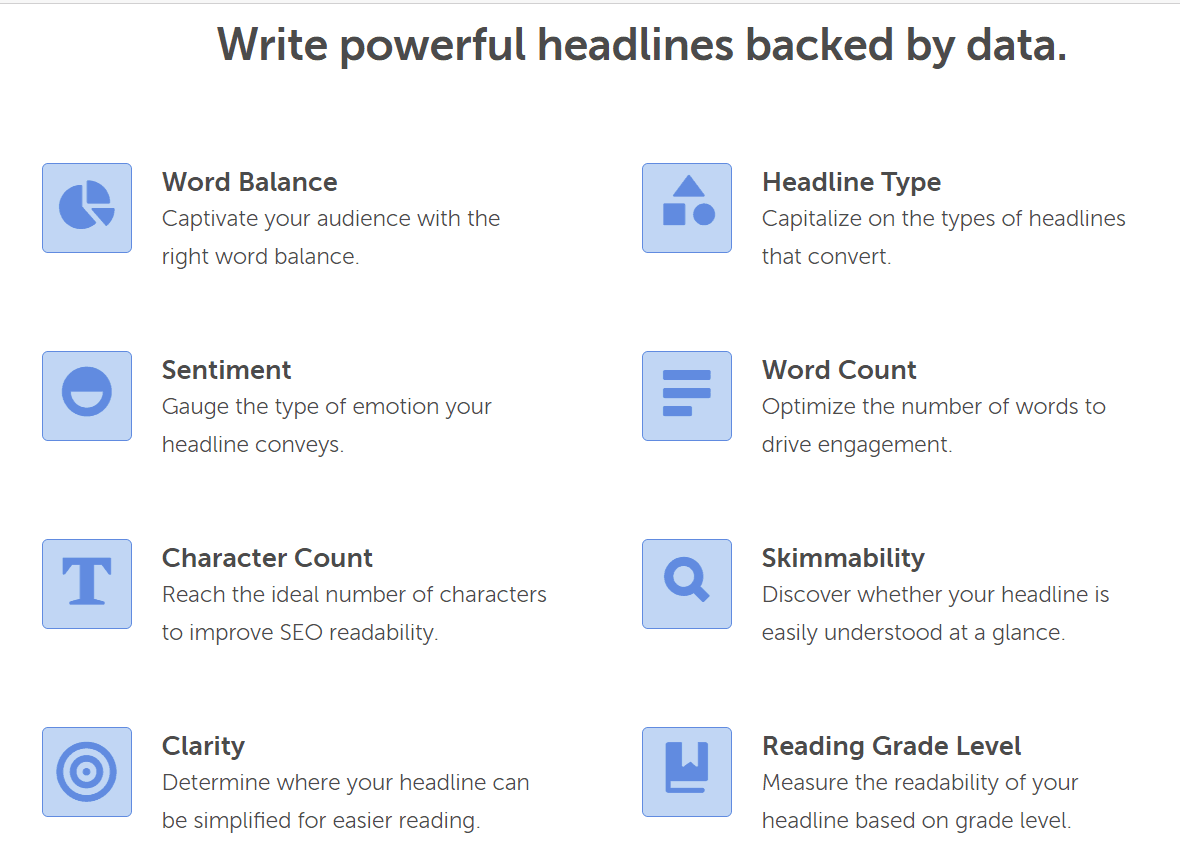
Equipped with tools to measure whether you’re using enough variety in your word choice, driving enough emotion for your readers, and optimizing your character length, the analyzer can help you craft that ideal headline to boost your sales.
But where can you turn to for inspiration?
Ad Headlines to Inspire You
Before you start writing your headline drafts, it’s a good idea to revisit the golden hits of advertising. Time and again, brands have attempted to create the most eye-catching headline. Most have failed where others have hit the jackpot.
Let’s jump into some advertising copy examples that were a hit with their audiences.
“They Laughed When I Sat Down At the Piano But When I Started to Play!~”
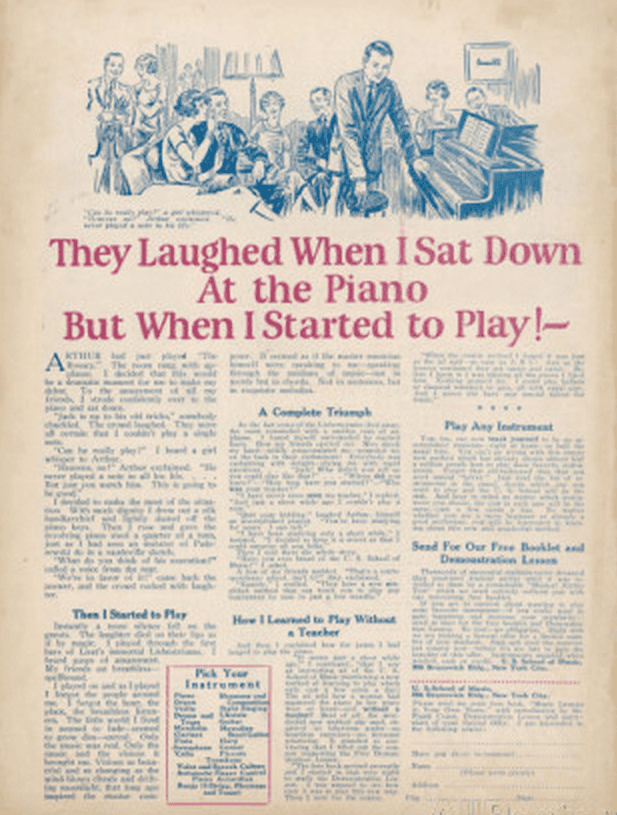
This ad, published in 1926, is the first of its kind. The format follows the “this happened” but “then something surprising happened” setup. The man behind the ad is John Caples, and he paved the way for the type of marketing that is less direct in its message. This is a great example of what’s commonly referred to as a curiosity gap — “the void between what you know and what you want to know.”
Instead of going for the pushy sales bit, it revolves around a story that directly affects people’s emotions; it captures the audience with the promise of emotional catharsis. The story is about an underdog who wins one, even though nobody believes in him.
The ad works because the engaging format and relatable anecdote help people imagine themselves in the same situation.
“At 60 miles an hour the loudest noise in this new Rolls-Royce comes from the electric clock”
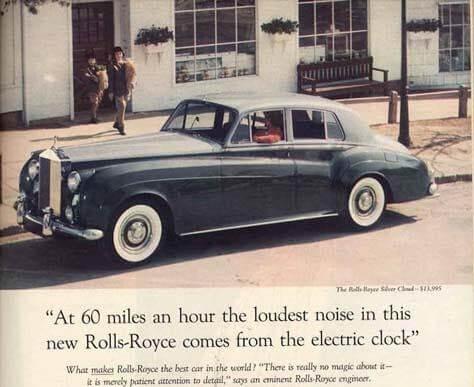
David Ogilvy will always be remembered as one of the best ad writers in the industry — the original Mad Men. According to his book, How to Write Potent Copy, this headline from 1958 is his favorite.
Just like with his other work, this copy was not born in one sitting, either. It took 26 drafts and six freelancers to come up with the final line. Today, most marketers use this strategy only when ad money is at stake, such as for PPC campaigns. But why not use it for content marketing?
Ogilvy’s Rolls-Royce campaign helped the company grow its sales by 50% the next year. No wonder, as their previous tagline was “the world’s best car”.
Ogilvy was way ahead of his time. This headline puts you in the driver’s seat. It presents you with multiple sensations, such as “60 miles an hour” (speed) and “loudest noise” (sound). The brilliantly placed twist at the end leaves you surprised and wanting more.
Ogilvy knew that the target market for a Rolls-Royce is not only car-savvy but easily swooned by the luxurious features. The ad works because it presents one distinct feature in the form of a vivid experience.
“You can still dunk in the dark”
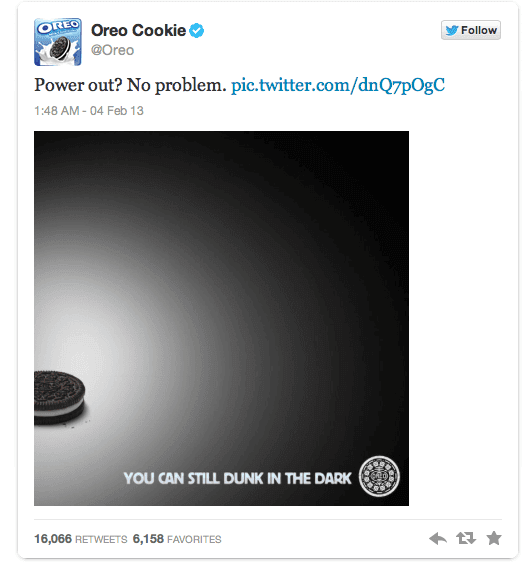
What do you do when you have to come up with a witty tagline on the spot? Oreo’s marketers seem to know the recipe for success. In 2013, when a massive power outage hit during the Super Bowl, Oreo went ahead and stole the show.
“We had a mission control set up at our office with the brand and 360i, and when the blackout happened, the team looked at it as an opportunity,” agency president, Sarah Hofstetter, told BuzzFeed. “Because the brand team was there, it was easy to get approvals and get it up in minutes.”
The timing was a crucial element in the success of this headline. They came up with it quickly when everyone in the stadium was on their phones due to the blackout. The line itself was relatable, and the play on words made it memorable.
The tweet gained almost 14K retweets.
How can you replicate this? Have a contingency plan for quick opportunities, keep the message simple, and measure your results.
“Where’s the beef?”

This is a classic ad that’s still vivid in pop culture’s memory. Wendy’s ad shows no mercy; their ad is about competitors’ shortcomings. As the two adorable ladies discuss the ridiculously small beef patty in their burger, the third one suddenly screams the famous line: “Where’s the beef?”
This catchphrase is intended to point out how all other hamburger joints were miles behind Wendy’s in size and quality. This ad only ran for about a year, starting in 1984. Audiences today cannot be shocked as easily anymore, but back in the 80s, you didn’t expect a bunch of sweet old ladies to make a scene about beef in a TV ad.
It also works because it shows the viewer how bad they would have it at any other burger place. At Wendy’s, you are taken care of; you get a sizable burger, and there’s no frustration — only instant comfort food.
“To all those who use our competitors’ products: Happy Father’s Day.”

Durex has been known for its witty ads for decades. Their tongue-in-cheek ad copy goes well with the brand’s casual tone. They consistently approach the otherwise taboo subject matter with humor, which stands out in a sea of boring ads.
Durex’s message is clear. Their product is superior to their competitors — so much so that they are ready to wish them a Happy Father’s Day. The timing and the surprise factors are both reasons why this ad works so well. They also know that their audience will be receptive to the multi-layered joke.
Durex is a big brand that can easily gain recognition with simple, snappy ads like these. So, how do you replicate that?
It’s all about brand consistency. Even small startups can gain a loyal following if they establish consistent branding. First, create your brand guidelines, and then you can dive into the world of multi-layered ads that stay true to your brand voice.
“Somewhere on an airplane, a man is trying to rip open a small bag of peanuts.”
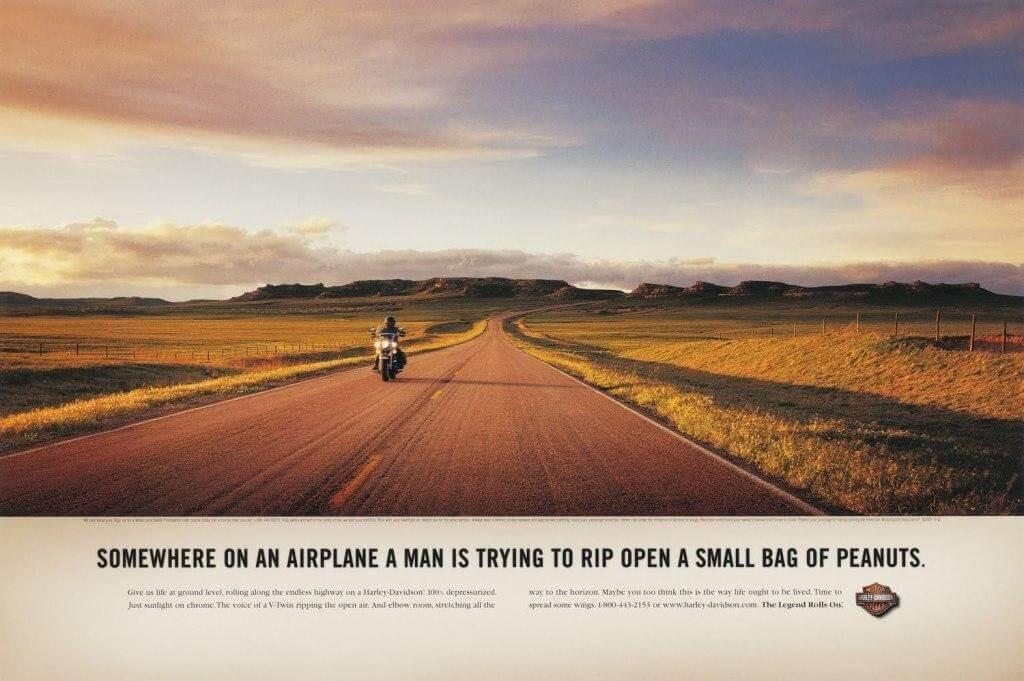
This Harley Davidson ad is nothing but graphics, copy, and timing working in perfect harmony. This ad landed in a motorbike magazine in January 2002. At the time, the shock of 9/11 was still fresh. Distrust in flying was at an all-time high.
This is why they embraced the narrative of freedom on the road even more than before.
The copy itself is carefully crafted to paint a picture: “Somewhere on an airplane” places you in a confined space. “A man is trying to rip open” conveys that the bag is annoyingly tightly sealed and won’t open easily, or maybe the man is limited in space and can’t use his full force to open the bag. “A small bag of peanuts” adds a shade of insult — all this work for a measly, small bag of peanuts?
You’ve just been placed into this confined, unnerving situation through words, then you look at the photo, and the whole experience comes together.
On a Harley, you can be free. You can take in amazing views and go where you please. You can probably stop at a burger joint and have yourself some real food any time.
This ad is the perfect example of why great design needs excellent copy and vice versa. This is true for ads, social media posts, and especially for design-heavy websites.
“I slept with your roommate. @YourCrazyExMattress”

About 35% of American adultsare not getting enough sleep every night. In response, mattress businesses have revamped their approach in recent years. Casper is a mattress company known for its flexible terms to mattress buying (old mattress removal, free delivery, 100-day trial, etc.) and its witty ads.
This particular ad promotes its old mattress removal by pretending to be a “crazy ex” mattress. The campaign also included an active Twitter account with the @YourCrazyExMattress handle. Even with all the creative billboards out there, you hardly expect to see one with a startling confession. It makes you stop and think for a second.
The Casper brand is most popular among 25 to 35-year-old professionals who are too busy to visit multiple mattress stores but love to shop online. The ad works because, by this point in life, they have likely dealt with a crazy ex before. Therefore, they can relate to the ad and have a good laugh.
The Twitter account is the cherry on top. It expands the ad onto a different platform and keeps the audience engaged (Note: the account is no longer available, unfortunately).
Casper started in 2014 as just a few guys trying to sell mattresses direct-to-customer. They soon went from zero to a company worth $750 million. Their success was almost entirely thanks to their ability to understand their audiences.
The lesson learned here? Know your audience inside and out, do a ton of user-centric conversion rate optimization, and, of course, have some fun with your ads.
“Mmphfffh”
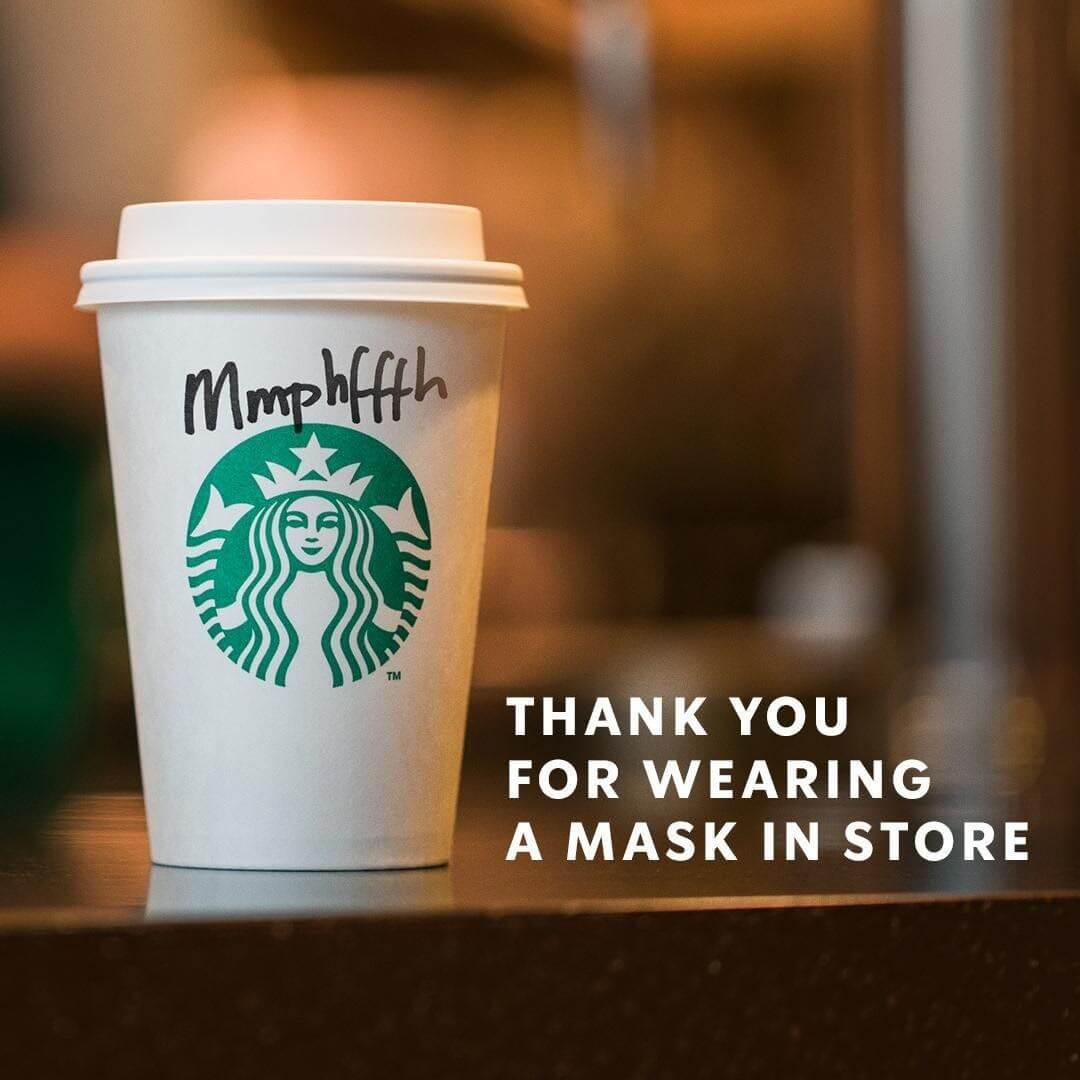
Some ads don’t even need to have intelligible words to work. In the COVID-19 era, most companies are taking charge to remind customers about public safety measures. There’s only a handful of ways you can say, “Please wear your mask,” so Starbucks decided to put their own spin on it.
Starbucks is known to have its baristas write the customers’ names on the cups. Misheard, misspelled names are always a source of fun among patrons. They recognized this and ran with it.
The ad works because of this shared inside joke. Through a mask, a lot of our names probably do sound like “Mmphfffh.” When reading the banner, you instantly imagine the scenario. This ad is an excellent ad copy example of “show, don’t tell”.
Creative ads from big companies, like Starbucks, usually have no problem going viral, as customers and media outlets are always keeping an eye on them, but what if you’re still a small fish in the sea? Get active on social media and learn the ropes of basic PR outreach. Soon enough, you might see your engaging ads on a roundup post of its own!
Key Takeaways
As you can see from the examples, writing interesting advertising headlines can be fun. Modern-day ads have become much more casual in their tone, which leaves marketers with more room to drum up something catchy.
If you are facing writer’s block — just as ads evolved from traditionally salesy to personal and witty — the next change also might be around the corner.
If you feel all these fantastic classic ad headlines have inspired you, start crafting your own! It’s time to put your new knowledge to the test and impress your waiting audience with the perfect headline.

